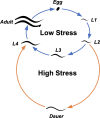Caenorhabditis elegans dauers vary recovery in response to bacteria from natural habitat
- PMID: 33005351
- PMCID: PMC7520223
- DOI: 10.1002/ece3.6646
Caenorhabditis elegans dauers vary recovery in response to bacteria from natural habitat
Abstract
Many species use dormant stages for habitat selection by tying recovery to informative external cues. Other species have an undiscerning strategy in which they recover randomly despite having advanced sensory systems. We investigated whether elements of a species' habitat structure and life history can bar it from developing a discerning recovery strategy. The nematode Caenorhabditis elegans has a dormant stage called the dauer larva that disperses between habitat patches. On one hand, C. elegans colonization success is profoundly influenced by the bacteria found in its habitat patches, so we might expect this to select for a discerning strategy. On the other hand, C. elegans' habitat structure and life history suggest that there is no fitness benefit to varying recovery, which might select for an undiscerning strategy. We exposed dauers of three genotypes to a range of bacteria acquired from the worms' natural habitat. We found that C. elegans dauers recover in all conditions but increase recovery on certain bacteria depending on the worm's genotype, suggesting a combination of undiscerning and discerning strategies. Additionally, the worms' responses did not match the bacteria's objective quality, suggesting that their decision is based on other characteristics.
Keywords: Caenorhabditis elegans; bacteria; dauer; dormancy; habitat.
© 2020 The Authors. Ecology and Evolution published by John Wiley & Sons Ltd.
Figures



Similar articles
-
Colony level fitness analysis identifies a trade-off between population growth rate and dauer yield in Caenorhabditis elegans.BMC Ecol Evol. 2024 Jan 25;24(1):13. doi: 10.1186/s12862-024-02199-1. BMC Ecol Evol. 2024. PMID: 38267842 Free PMC article.
-
The evolution of plasticity of dauer larva developmental arrest in the nematode Caenorhabditis elegans.Ecol Evol. 2015 Mar;5(6):1343-53. doi: 10.1002/ece3.1436. Epub 2015 Mar 2. Ecol Evol. 2015. PMID: 25859338 Free PMC article.
-
Caenorhabditis elegans processes sensory information to choose between freeloading and self-defense strategies.Elife. 2020 May 5;9:e56186. doi: 10.7554/eLife.56186. Elife. 2020. PMID: 32367802 Free PMC article.
-
[Genetics and evolution of developmental plasticity in the nematode C. elegans: Environmental induction of the dauer stage].Biol Aujourdhui. 2020;214(1-2):45-53. doi: 10.1051/jbio/2020006. Epub 2020 Aug 10. Biol Aujourdhui. 2020. PMID: 32773029 Review. French.
-
The determinants of lifespan in the nematode Caenorhabditis elegans: a short primer.Sci Prog. 2004;87(Pt 4):227-47. doi: 10.3184/003685004783238472. Sci Prog. 2004. PMID: 16028834 Free PMC article. Review.
Cited by
-
Multidimensional competition of nematodes affects plastic traits in a beetle ecosystem.Front Cell Dev Biol. 2022 Aug 24;10:985831. doi: 10.3389/fcell.2022.985831. eCollection 2022. Front Cell Dev Biol. 2022. PMID: 36092706 Free PMC article.
-
Interspecies relationships of natural amoebae and bacteria with C. elegans create environments propitious for multigenerational diapause.mSystems. 2025 Apr 22;10(4):e0156624. doi: 10.1128/msystems.01566-24. Epub 2025 Mar 20. mSystems. 2025. PMID: 40111038 Free PMC article.
-
Transposon-mediated genic rearrangements underlie variation in small RNA pathways.Sci Adv. 2024 Sep 20;10(38):eado9461. doi: 10.1126/sciadv.ado9461. Epub 2024 Sep 20. Sci Adv. 2024. PMID: 39303031 Free PMC article.
-
Dauer fate in a Caenorhabditis elegans Boolean network model.PeerJ. 2023 Jan 23;11:e14713. doi: 10.7717/peerj.14713. eCollection 2023. PeerJ. 2023. PMID: 36710867 Free PMC article.
-
Taxonomic and phenotypic characterization of a novel Providencia species: Providencia lanzhouensis sp. nov.Microbiol Spectr. 2025 Aug 5;13(8):e0054925. doi: 10.1128/spectrum.00549-25. Epub 2025 Jul 9. Microbiol Spectr. 2025. PMID: 40631741 Free PMC article.
References
-
- Baskin, C. C. , & Baskin, J. M. (1998). Seeds: Ecology, biogeography, and evolution of dormancy and germination. San Diego, CA: Academic Press.
-
- Burke, R. D. (1986). Pheromones and the gregarious settlement of marine invertebrate larvae. Bulletin of Marine Science, 39, 323–331.
-
- Cassada, R. C. , & Russell, R. L. (1975). Dauerlarva, a post‐embryonic developmental variant of nematode Caenorhabditis elegans . Developmental Biology, 46, 326–342. - PubMed
-
- Chew, F. S. (1977). Coevolution of pierid butterflies and their cruciferous foodplants. 2. Distribution of eggs on potential foodplants. Evolution, 31, 568–579. - PubMed
Associated data
Grants and funding
LinkOut - more resources
Full Text Sources

